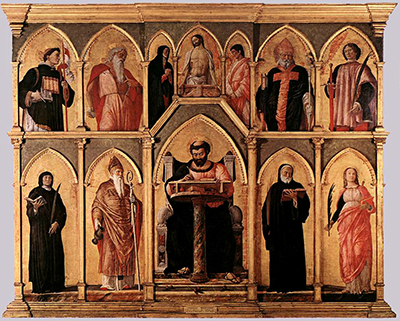The San Luca Altarpiece is a polyptych panel painting by Andrea Mantegna, a Northern Italian Renaissance painter.
The painting features 12 figures with an arch on each figure. At the top are seven figures who are important to Jesus Christ, while the five below are Saint Luke. The altarpiece painting was commissioned when Mantegna was 22 years old in 1453, in the S. Luca chapel in the church of S. Giustina in Padua. From the upper left, we have St. Daniel of Padua, St. Jerome, the Virgin, Christ, St. John, St. Augustine, St. Sebastian, St. Scholastica, St. Prosdomicus, St. Benedict, and St. Justina.
In the 17th century, the original wooden frame where Mantegna’s signature was inscribed was struck by lightning. The loss of this piece has altered the composition of the painting, which is notable when you look at the scale between the 2 registers. The painting is said to have been commissioned by donors to bring about a Gothic masterpiece. The insertion of a thick moulding between two orders is a great achievement by Mantegna. This separation set the two ranges apart in the earlier days than they are today. Mantegna also used a composition where the support panels were smaller to create a distance while the lower panels were created larger to showcase how the viewer is close to them.
The separate figures are highly impressive even without their original framework. The wet drapery of the painting creates an illusionistic effect on the figures to present a great quality in Mantegna’s work, which must have originated from his studies on classic Roman sculpture. The painting was created in a time when the two brothers-in-law had an intense dialogue about Mantegna's marriage to Giovanni Bellini's sister, Nicolosia. The painting is a demonstration of the adhesion the monastery of Santa Giustina had to the new Benedictine rule.
Mantegna signed a contract on August 10th, 1453 to paint the Santa Giustina in Padua for 50 ducats. He worked with paints to depict the figure and the azzuro Todesco, which is a blue pigment sourced from copper, to inlay them. The painting is now in Pinacoteca de Brera in Milan.




